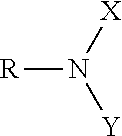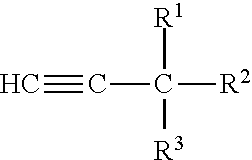Method of Mitigating Corrosion Rate of Oilfield Tubular Goods
a technology of oilfield tubular goods and corrosion rate, which is applied in the direction of fluid removal, chemistry apparatus and processes, and wellbore/well accessories, etc., can solve the problems of iron and steel surfaces corroding, acidic corrosion of production or workover conduits used in wells in such applications, and aggravated corrosion problems
- Summary
- Abstract
- Description
- Claims
- Application Information
AI Technical Summary
Problems solved by technology
Method used
Image
Examples
example 1
[0055]Two different blends were formulated, all percents are volume percents:
[0056]Blend #1: 15% HCl+2% CI 300+25 pptg (3 kg / m3) CII 107+15 pptg (1.8 kg / m3) FE 120+2 gptg ST 102+2 gptg NE 100+5% MS-90
[0057]Blend #2: 15% HCl+2% CI 300+15 pptg (1.8 kg / m3) FE 120+2 gptg ST 102+2 gptg NE 100+5% MS-90+20 pptg (2.4 kg / m3) CII 107+20 pptg (2.4 kg / m3) CII 109
CI 300—Corrosion Inhibitor
[0058]FE 120—Iron control agent
ST 102—Surface tension reducing agent
NE 100—Non Emulsifier
MS 90—Mutual Solvent
CII 109—Cupric Acetate Monohydrate
[0059]Acid Blends #1 and #2 were tested on four different alloys with the results shown in Table I. It may be seen that the inventive additive Blend #2 inhibited corrosion to a much greater extent than did Blend #1 without CII 109. The quantities of the metal loss are expressed in lbs / ft2 (kg / m2).
TABLE IComparison of Blends #1 and #2 on Four Metal AlloysTemperature 220° F. (104° C.) for 24 hrsType of MetalAcid Blend #1Acid Blend #2SM 13 Cr0.2378 (...
example 2
[0060]Two additional, different blends were formulated. Again, all percents are volume percents:
[0061]Blend 3: 5% HCl+13% Acetic+9% Formic+0.2% AG-195+2% FE-125L+0.2% NE-100+2% CI-300+0.5% BI-100
[0062]Blend 4: 5% HCl+13% Acetic+9% Formic+0.2% AG-195+2% FE-125L+0.2% NE-100+2% CI-300+0.5% BI-100+15 pptg CII 107+15 pptg CII 109
AG-195—Acid friction reducer and / or gelling agent
FE-125L—Iron control agent
BI-100—H2S scavenger
[0063]Acid Blends 1 and 2 were tested on alloys VM 22 with the results shown in Table II. It may be seen that the inventive additive Blend #2 inhibited corrosion to a much greater extent than did Blend #1 without CII 109. Again, the quantities of the metal loss are expressed in lbs / ft2 (kg / m2).
TABLE IICorrosion Testing on VM 22Temperature 300° F. (149° C.) for 10 hrs at 400 psi (2.8 MPa)Corrosion Loss lbs / sq ft (kg / m2)Type of MetalAcid Blend 3 Acid Blend 4VM 220.0164 (0.080)0.0025 (0.012)
[0064]The compositions herein have been found to have excellent stability, thus avo...
PUM
| Property | Measurement | Unit |
|---|---|---|
| temperatures | aaaaa | aaaaa |
| density | aaaaa | aaaaa |
| density | aaaaa | aaaaa |
Abstract
Description
Claims
Application Information
 Login to View More
Login to View More - R&D
- Intellectual Property
- Life Sciences
- Materials
- Tech Scout
- Unparalleled Data Quality
- Higher Quality Content
- 60% Fewer Hallucinations
Browse by: Latest US Patents, China's latest patents, Technical Efficacy Thesaurus, Application Domain, Technology Topic, Popular Technical Reports.
© 2025 PatSnap. All rights reserved.Legal|Privacy policy|Modern Slavery Act Transparency Statement|Sitemap|About US| Contact US: help@patsnap.com


